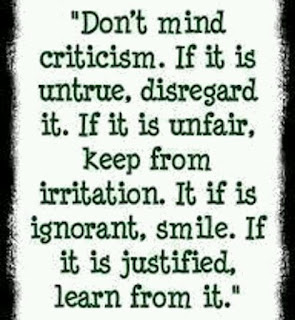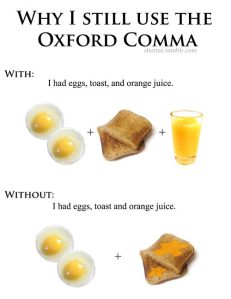The word "criticism" and its connotations...
Writers often conflate the idea that criticism and negative criticism are the same thing, often forgetting that there is also such a thing as positive criticism. I would dare to bet that many new writers think that "positive criticism" is either an oxymoron or means that positive criticism is just negative criticism said in a nice way.In fact, "criticism" is a neutral word, just as "quality" is a neutral word, because there is good quality and bad quality. But enough of these distinctions. I want to talk about how writers should strive to accept criticism from readers, whether positive or negative, both the bad things the writer perceives is said about her work and the positive things the writer longs to hear.
Positive criticisms are notes readers or editors will write in the margins like, "This is a powerful sentence," "I loved the way you brought all the conflicts together in this one paragraph," "Nice imagery..." Positive criticism of this sort is both nice to hear and might be instructive as to what the reader or editor thinks the writer did well—and the writer can learn a little something about writing from these bits of praise sprinkled throughout a manuscript. But in the end, it is the negative criticism that writers should listen to the most.
This is the kind of criticism that initially makes the writer angry, hurt, and defensive. The writer should refrain from letting those emotions show. Nor should the writer try to defend herself or justify herself any way to the editor.
Having one's work edited or critiqued should not devolve into an adversarial relationship. Oh sure, editors can be wrong, the criticism can be irrelevant, and ultimately, when the writer is alone with the edited manuscript she is free to reject everything the editor has indicated. But it's not a good idea to fire back a heated response to the editor—ever.
There is one caveat about negative criticism that the writer should never put up with and an editor should never do, and that is to deliver blistering criticism, done in a mean way. A good editor should never say anything like, "This is the stupidest simile I have ever read," "This paragraph should be deleted, since it ruins the entire plot of the novel." And perhaps that is what writers fear about having their work edited and criticized. But as an editor for almost four decades, I can say that editors who plan to stay in the business are simply not going to do that to a writer. So, really nasty, bad, horrible negative criticism is nothing to fear, nothing to be defensive about, nothing to keep a writer up at night. Honest criticism is what writers should be glad to receive and what editors should not be afraid to deliver. As an editor I will tell a client that the book is not ready for publication, and on a sliding scale I will say the book is still in a rough-draft stage, is in a stage where some revision is still necessary (in my opinion), or that a draft is as polished as the writer is likely to get it and should indeed be submitted to a literary agent or typeset and sent to a printing service.
Even if a writer feels hurt by criticism from an editor, the vast majority of the time, if the criticism hurts and causes the writer pain, it's probably a good and relevant criticism; otherwise, it wouldn't hurt. If the writer can brush off negative criticism and doesn't feel anything more than mild irritation with a comment about her work, it probably is an off-beam comment by the editor.
It's those little poison darts that get us where it hurts that writers should pay attention to and consider thoughtfully. This is where writers will learn the most about writing; this is where a writer's skill and the book in question will improve.
As a writer, of course I read all the positive reviews that have been posted about my work. Praise is nice to hear. But I also read all the negative reviews, and once I get over the immediate anger and defensiveness that a negative review automatically engenders in me, I take the negative review into consideration. Amid all the positive reviews about one of my book series, one particular reader went out of his way to essentially say the same thing about each of my books, giving them a one-star rating on Amazon. Ultimately, while there was some merit about what he said about my main characters (they cry a lot), I gleaned that he didn't like the concept of my stories, which must have gone against his own idea of what characters like mine should strive for, and so he struck out in anger in language that was simply incendiary. Eventually, I was able to shrug off most of his criticism, but the thing about my main characters crying a lot was true. Another negative review had to do with my very long, very detailed, very dense fantasy novel. A different reader, not the mean one, said it was the kind of book a person should read if he or she is stuck in bed with the flu. The reviewer was not mean-spirited in the least, and his comment was clever. This was negative criticism about whether or not my novel was boring. I have no problem realizing that some readers might find a 350,000 word novel a little too detailed for his tastes. In fact, one of my beta readers whose opinion I respected (he was also my boss) said that I should cut the content of the fantasy novel by 75 percent. Ouch! In this case, however, I didn't take his advice. I believe that I had good reason to keep what I wrote, and so I thanked him for reading the manuscript and carried through with my plans for this mammoth book.
Writers should strive for excellence, and engaging the services of an editor or proofreader is essential, because once a work is published, once a writer's baby is dressed up and sent off to be sold to the reading public it's too late to do the revision, correct mistakes, or otherwise get a "do-over." Of course if it is only in ebook form that doesn't apply.
That is why it is important for writers to listen carefully to the negative criticism from editors and beta readers and to think strongly about revising what the editor and readers have said before the book is published.
A whole other consideration about the fear of criticism, however, is that writers should not write to avoid negative feedback, should not avoid offending anyone, because there will always be a certain number of people that will dislike a book, be offended by the content of a book, or find something wrong with it. Writers should always write to please themselves first, but that is a different topic.











